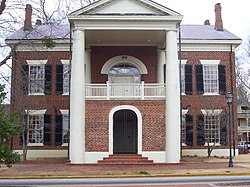Dahlonega, Georgia
| Dahlonega, Georgia, USA | |
|---|---|
| City | |

Historic Lumpkin County Courthouse, which now houses the Dahlonega Gold Museum Historic Site
|
|
| Nickname(s): Gold City | |
 Location in Lumpkin County and the state of Georgia |
|
| Coordinates: 34°32′N 83°59′W / 34.533°N 83.983°WCoordinates: 34°32′N 83°59′W / 34.533°N 83.983°W | |
| Country | United States |
| State | Georgia |
| County | Lumpkin |
| Government | |
| • Mayor | Gary McCullough |
| • City Manager | Bill Schmid |
| Area | |
| • Total | 6.4 sq mi (16.6 km2) |
| • Land | 6.4 sq mi (16.6 km2) |
| • Water | 0.0 sq mi (0 km2) |
| Elevation | 1,450 ft (442 m) |
| Population (2010) | |
| • Total | 5,242 |
| • Density | 568.1/sq mi (219.5/km2) |
| Time zone | EST (UTC-5) |
| • Summer (DST) | EDT (UTC-4) |
| ZIP codes | 30533, 30597 |
| Area code(s) | 706 |
| FIPS code | 13-21240 |
| GNIS feature ID | 0355420 |
| Website | http://dahlonega-ga.gov/ |
| http://dahlonega-ga.gov/ | |
The city of Dahlonega is the county seat of Lumpkin County, Georgia, United States. As of the 2010 census, the city had a population of 5,242.
Dahlonega is located at the north end of Georgia 400, which connects Atlanta to many suburbs to the north. It is consistently named as a best place to retire by many different publications due to its low cost of living, vibrant activities, continuing education for seniors, festivals, and beautiful setting.
In 1828 Dahlonega was the site of the first major gold rush in the United States. The Dahlonega Gold Museum Historic Site stands in the middle of the town square, housed in the 1836 Lumpkin County Courthouse. From its steps in 1849, Dahlonega Mint assayor Dr. M. F. Stephenson tried to persuade miners to stay in Dahlonega instead of joining the California Gold Rush, saying, "There's millions in it," famously misquoted as "There's gold in them thar hills."
Dahlonega is home to a campus of the University of North Georgia.
In 1829, Dahlonega became the site of the second significant gold rush in the US and became a boom town of the Georgia Gold Rush.
Dahlonega was home to many Creeks and Cherokees. There are a few Creek and Cherokee descendants in Dahlonega today, though not in distinct communities but scattered throughout the area. Most of the descendants are mixed Cherokee. Names like Corn, Davis, Chambers, Dover, Chattin, and Bird are of Cherokee blood. Surnames like Thrasher are of Creek blood. Though not afforded state or federal recognition, these families still hold onto who they are as Cherokee and Creek people. The Cherokee called the area ᏓᎶᏂᎨ or Da-lo-ni-ge, which means yellow (from the Dikaneisdi (Word List) of the Cherokee Nation); George Featherstonhough, an English geologist who visited the town in 1837, observed that the courthouse, designed by Ephriam Clayton, was built upon a broad expanse of hornblende slate "and that the soil of the public square was impregnated with small specks of gold." The courthouse building was paid for in part with gold bullion, using bricks likely made in Lumpkin County (although possibly transported from Augusta), with both its foundation stone and timber obtained locally.
...
Wikipedia
